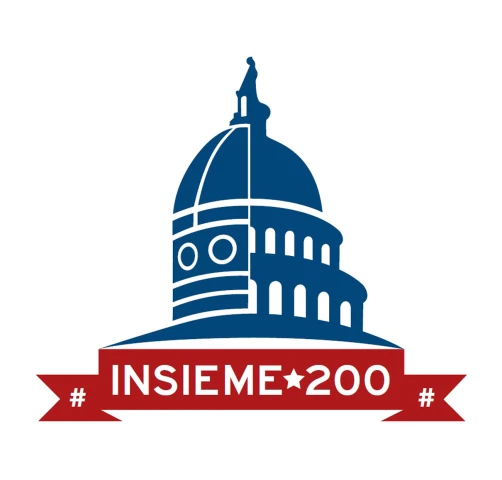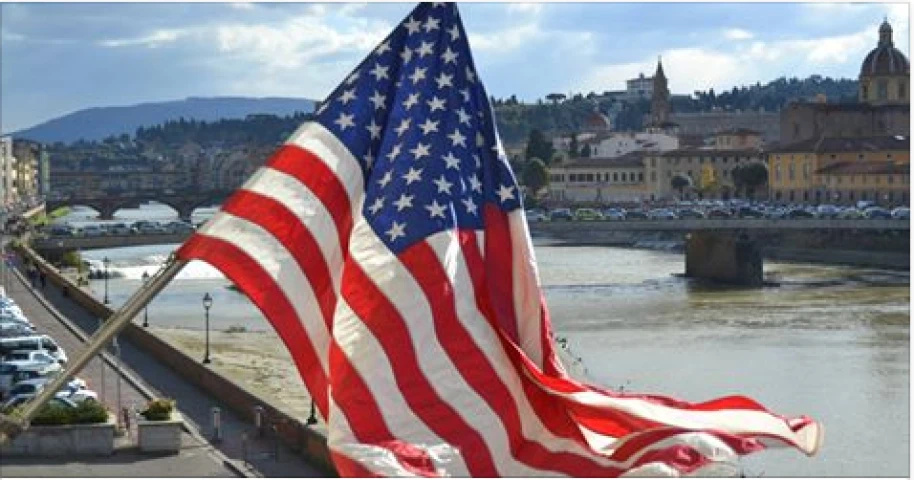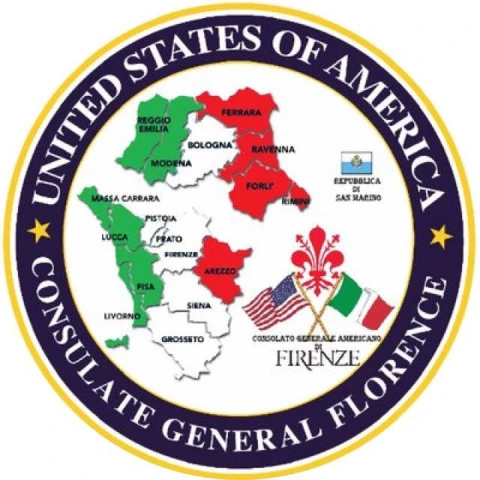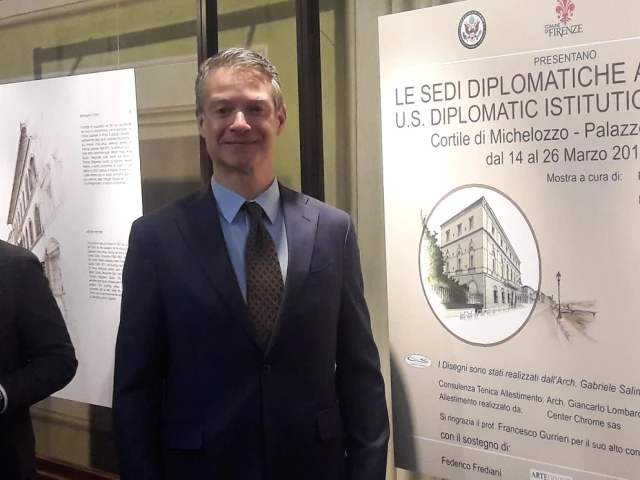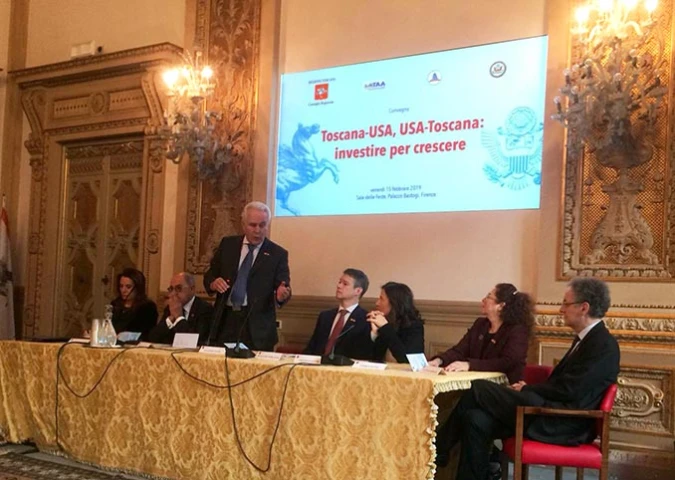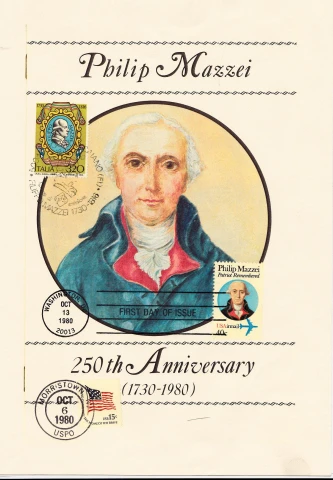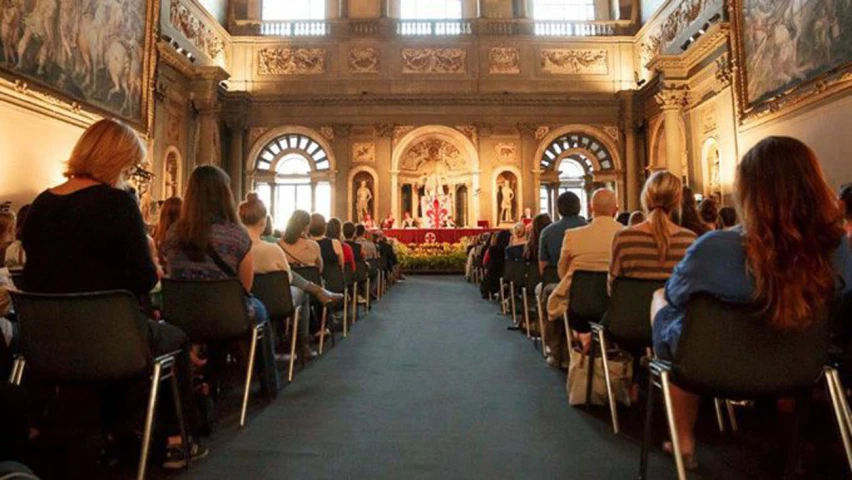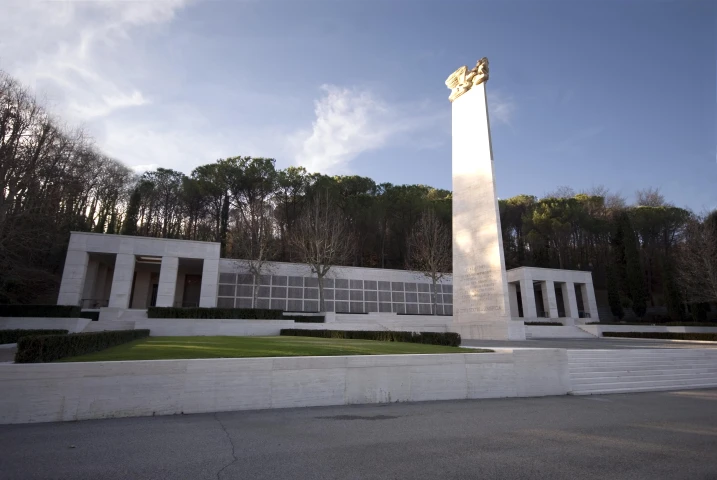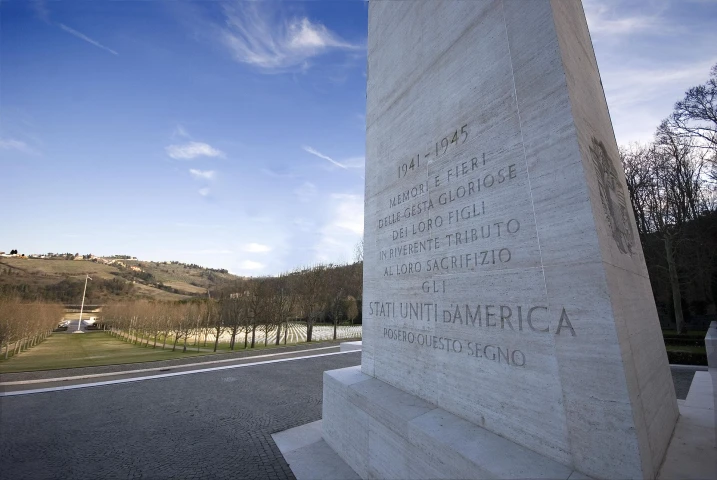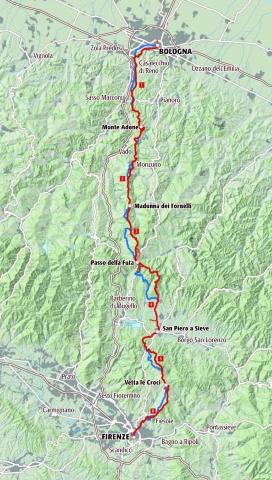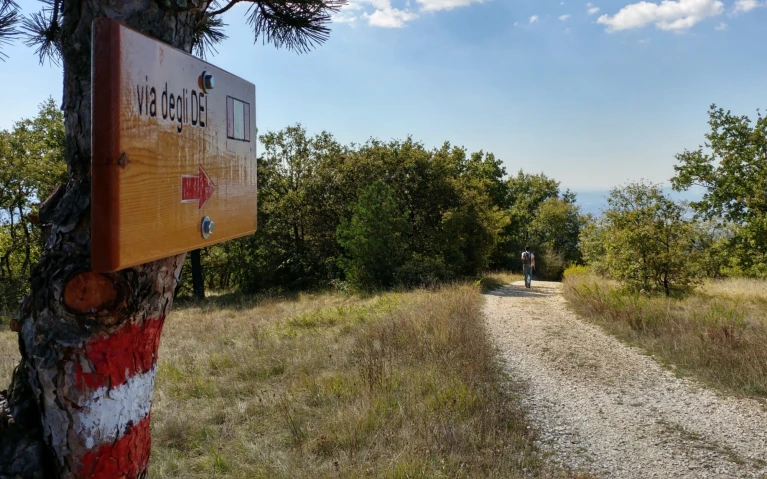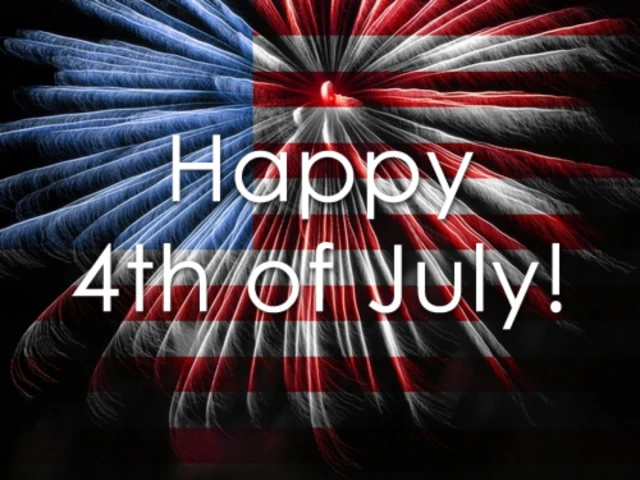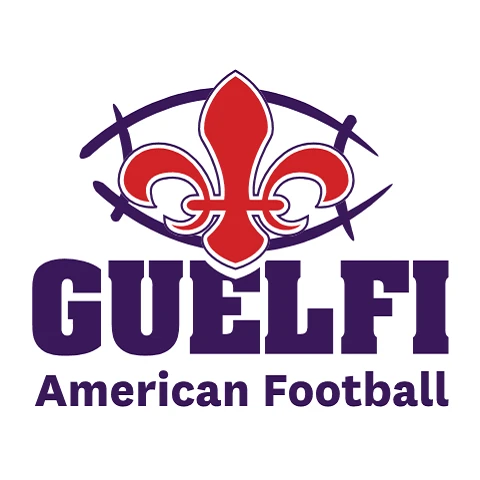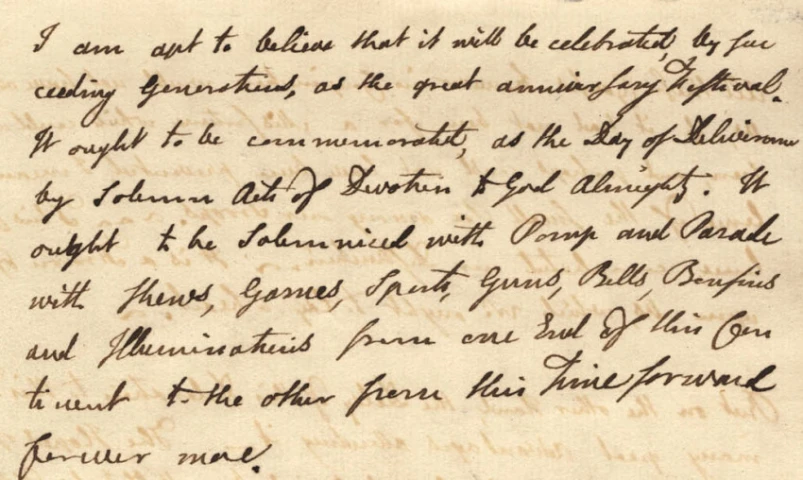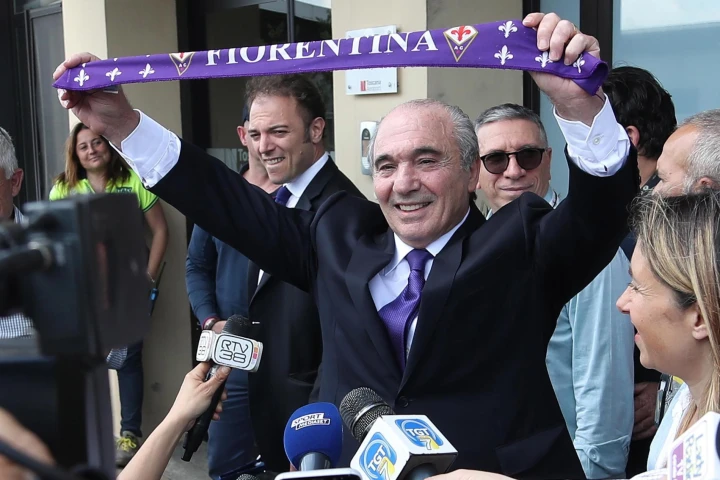The year 2019 sees the ongoing celebration of the 200th anniversary of diplomatic relations between the then young democracy of the United States and the Grand Duchy of Tuscany. The events, which last throughout the year, are organized by various public and private entities under the patronage of the American Consulate in Florence.
It's just a coincidence that a few days ago an American, better an Italian American, Rocco Commisso, bought the football team of Florence, the Fiorentina. But it is a further confirmation of the deep relationships that still today, 200 years after their beginning, indissolubly bind Tuscany and the United States. Our guest is Benjamin V. Wohlauer, American Consul in Florence: we thank him for his courtesy and wish him and all the United States a Happy 4th of July!
Mr. Wohlauer, 2019 is the 200th anniversary of the diplomatic relations between the United States and Tuscany. We are not going to ask you to summarize 200 years in a single answer, but maybe you could tell our readers the main steps of this relationship?
Yes. The first consulate was in Livorno, established in 1794. In 1819 that consul in Livorno decided that he needed assistance, basically someone to help him out in Florence. The reason was because the number of American artists coming to Florence was growing every year, and there was a great need to help them to get into the Accademia. Besides, there was the need of having someone in the capital of the Granducato di Toscana, to maintain relations with the court.
So the first chapter, I would say, is made by those early days where the diplomatic relations between Tuscany and the United States, which was a very new country at that time, were established. In that time many American artists traveled to Tuscany, keeping in mind that in 1819 travel from the United States was extremely difficult, expensive and dangerous. It took a long time, so these people were really dedicated.
The next chapter, I would say, would be after unification of Italy: the United States had its Civil War at the same time when the Italian Unification was coming to a conclusion with the final wars of independence. This is the period between 1865 and 1871, and this second chapter is the first one between two modern nations forging the relationship that we now see today. A lot of that early relationship building happened here in Florence.
The third chapter, I would say, would be during the world wars. By then, the U.S. had become a world power. During World War I very few Americans saw action in Italy, although there was a U.S. naval aviation base near Ravenna and the American Red Cross was very active in Tuscany and Emilia Romagna. Then of course, World War II is perhaps the most important chapter of our shared history, because of the intensity of the contact between Americans and Italians.
And then there’s the fourth chapter, the one I think we're in now: the post-war period, which I think has been defined by a real explosion in economic and cultural ties. One of the biggest stories about this new chapter is the increasing presence of American universities here, which is a pillar of our bilateral relationship now. A number of programs have been here fifty or even sixty years. In fact, Syracuse University is celebrating 60 years in Florence this year, and the University of Georgia is celebrating 50 years. The other part of this wonderful relationship is the economic prosperity that we share. There's always been commerce between Tuscany and the United States, but obviously in the last couple of decades there's been a lot more growth in both trade flows back and forth, and also investment.
So there are many things we have in common and our collaborations are in all different fields: we also still have a military presence in the province of Pisa.
#200together is the name and the hashtag of the cycle of events celebrating this 200th anniversary. Please tell us what is going on, which events have taken place and which ones are yet to be held
The objective of the year is to bring to light to all different stories and aspects of our partnership: historical, contemporary, and also looking towards the future together. I'm pleased that already this year we've seen about fifty individual events scheduled across the district. They are all about different small chapters in our shared history.
For example, we've had an event that looked at our physical presence in Florence. Architects who did beautiful drawings of all of the palaces and buildings that have hosted the consulate over the years. This was an exhibition at Palazzo Vecchio here in Florence. We've also had a very successful conference looking at the flows of investment between the United States in Tuscany, with American investors here and Tuscan investors in the United States sharing their experiences. We've had some events looking at the early days of our presence here, regarding the first Consul and his relationship with the Grand Duke, and with the American artists that were coming in. We’ve also had a baseball game in Livorno between the local baseball team and Americans from Camp Darby. We've got also an art exhibit that opened on the fourth of April right here in Florence, in the palace that hosted the U.S. embassy during the years when Florence was the capital. The exhibition is about contemporary American art, but in the space that in the XIXth century hosted American artists of that of that era. In Ravenna we had an event focusing on the 50th anniversary of the moon landing.
So there have been, are, and will be many different events that look at all sorts of aspects of our shared experience. It's a very exciting year! And I would encourage your readers to follow us on our Twitter account which is @USCGFlorence. There they can find all of the upcoming public events and also details about our shared history.
Several people emigrated from Tuscany to the United States. Their contribution improved every field of American culture, society and economy. The most important was Filippo Mazzei, close friend to Thomas Jefferson. As John Fitzgerald Kennedy wrote, “The great doctrine 'All men are created equal' and incorporated into the Declaration of Independence by Thomas Jefferson, was paraphrased from the writing of Philip Mazzei”…
An important theme of this bicentennial year is the central role played by individuals: we're celebrating the anniversary of our official relationship, but that really wouldn't have been possible without the millions of individual relationships created over the years. And one of the most important early relationships was the one between Filippo Mazzei and Thomas Jefferson.
It was a friendship that began in the 1770s. During his time in London, Mazzei got to know Benjamin Franklin, another of our founding fathers. After Franklin, he got to know Jefferson, who was very interested in hearing Mazzei’s ideas about political philosophy, as well as agriculture. In fact, Mazzei brought over olive seeds and also the first grapevines to the United States, specifically in Virginia. That really was one of the first bridges between Tuscany and the United States, and I think that spirit lives on today, highlighting the importance of these individual friendships and partnerships that enrich both countries.
As you mentioned, Florence is home to several different U.S. study abroad programs: 44 to be precise, and 17 others are spread throughout Tuscany. In fact, Tuscany is the Italian region with the highest number of them. How is the relationship between the city and this huge numbers of American boys and girls?
Again, going back to the theme of the importance of personal relationships, over the years we're talking about probably tens if not hundreds of thousands of American students who have come through Florence and Tuscany and also Bologna. They have engaged with many local people and I think they play a much more important role than the Consulate does in creating an impression about the United States. I think that the good feeling that most Florentines and people from Tuscany feel towards the United States comes from their interactions with these American students on a daily basis.
Some of those students engage in different activities. Students from James Madison University -- twice a year, together with local neighborhood associations -- go out and clean up the streets and walls over graffiti. It’s a great tradition. Another group of students from another American university teaches English every week to children in their neighborhoods in the public library system. And these are just two examples of dozens and dozens of American students who bring with them from the U.S. a volunteer spirit that comes naturally to them. So when they come over here, even if the context is different, they continue to have this desire to give back and to get involved in the community.
So, aside from the economic benefits that these university programs bring to Florence, I think that this sense of community service felt and shown by the students is very much appreciated by local authorities and people.
The Florence American Cemetery and Memorial is about 4.6 miles south of Florence. It is a blessed, beautiful place where 4,393 American soldiers are buried. Most of them died in the fighting that occurred after the liberation of Rome in June 1944 and in the fighting in the Apennines Mountains shortly before the war's end. Please, tell us what a sacred place like this represents for the American highest representative in this area?
As you said, the cemetery is in a beautiful and very peaceful location where a small fraction of the American military men and women who died between the liberation of Rome in June 1944 and the end of the war are buried. There also are about 1,400 Americans, mostly pilots, who are listed as missing in action.
I think it's important for Americans to remember this part of our history, to visit the cemetery, to see all of these crosses and stars of David lined up, and see the Wall of the Missing. Those young Americans came from all different backgrounds and places from all over the U.S. They came out to free Europe, and in those days most people didn't travel, so this was maybe the first time they'd ever been away from their hometown, for something that was more important than the individual.
I think that not many Americans understand this and know the story of this last part of the war, after the liberation of Rome, and I think it's important for Americans to come and see the difficult fighting and the number of U.S. casualties there were in this part of the the the war. I also think it’s important for Italians, especially the younger ones, to come in and know about these Americans who gave their life. It’s part of our shared history, a pillar upon which the bilateral relationship is created and formed, and it's one of the reasons why I think the U.S. and Italy have such an almost family-like relationship. Because of this shared horrible experience we had together during World War II...
Twice a year there is a very moving ceremony and I think they are very much worth attending. The first happens on Memorial Day (this year it was held on May 27th), the day in the United States that we commemorate those who have fallen during wartime. The second is November 11th, which in the United States we call Veterans’ Day, when we remember all of those who served.
The audience of our network is Italian American for the most part. As an American who lives in these areas (Tuscany and in southern part of Emilia Romagna), is there something maybe not particularly famous you would recommend to your fellow Americans?
I really enjoy walking and trekking, and I think that in general the paths where you can do it in Tuscany, Emilia Romagna, and San Marino are not known as much as they should be. You can have one-day treks or even trips for more than one day, starting from Florence or from Bologna. These are wonderful treks. I enjoy very much the “Via degli Dei,” the old Roman road that links Bologna and Arezzo passing over the Apennines through a few days of walking.
From Florence you can also hike some very short segments or you can do longer segments. I think the whole course from Bologna to Florence takes about seven days, but you can easily do day trips. But generally here you really have a lot of beautiful hiking you can do.
July 4th is Independence Day for the U.S. I’ve got two questions about this. The first one is: how are you and your Consulate are going to celebrate it?
Every year we host a reception here for local officials and contacts, and we will do the same thing this year. Because of the 200th anniversary we’re planning a little more action than we normally do. We also rely on our partners: often the Tuscan-American Association organizes a public July 4th celebration. We've also heard from the American football team in Florence which is called “The Guelfi,” that they might also be organizing something. So we're very keen to have our partners organize public events wherever they can, so that we can share the day with as many people as possible.
The second question about July 4th: is there something about how you Americans celebrate your national holiday that you think we could adopt here in Italy for our June 2nd? I am not so much talking about the institutions as about the ordinary people, and how they celebrate their community spirit and being together by commemorating this occasion.
The interesting thing about national holidays is that in every country there's always a national day, but it can mean different things in different countries. For the United States, July 4th is not just the date on the calendar, but our national identity is very much tied to the events surrounding this day. The signing and adoption of the Declaration of Independence for us not only was a formative moment for our country, but I think even today's Americans still feel very strongly and very patriotically about it.
Another aspect is that July 4th was always envisioned to be not a solemn holiday, even though it essentially marked the beginning of a war. It was always expected to be a festive holiday. John Adams, who was a founding father, was famous for saying about it: “It ought to be solemnized with Pomp and Parade, with Shews, Games, Sports, Guns, Bells, Bonfires and Illuminations from one End of this Continent to the other from this Time forward forever more.” And that basically is what still happens.
So the context for the July 4th celebration in the United States is unique. I think that Italians, because of their culture and their history, have other national or regional holidays that are are a part of their identity. For instance, I’m thinking about the Palio di Siena, which is much bigger celebration than the 4th of July: everybody is involved, there are banquets and parties, and it goes on for several days if not weeks.
I think it's always hard to import or export meaningful aspects: you can import and export superficial aspects, but I I think it really just depends on the national and regional or even local cultures, to find holidays that resonate. Because it's part of the identity and how people feel that way they will naturally celebrate in an enthusiastic way.
Nel 2019 vengono celebrati i 200 anni delle relazioni diplomatiche tra gli Stati Uniti, allora giovane democrazia, e il Granducato di Toscana. Gli eventi, che durano per tutto l’anno, sono organizzati da diversi soggetti pubblici e privati sotto il patrocinio del Consolato Americano a Firenze.
E' solo un caso se qualche giorno fa un americano, meglio un italoamericano, Rocco Commisso, ha comprato la squadra di calcio di Firenze, la Fiorentina. Ma è un ulteriore conferma delle profonde relazioni che ancora oggi, a 200 anni dal loro inizio, legano indissolubilmente la Toscana e gli Stati Uniti. Il nostro ospite è Benjamin V. Wohlauer, Console Americano a Firenze: lo ringraziamo per la sua cortesia e auguriamo a lui e per suo tramite a tutti gli Stati Uniti anche Buon 4 luglio!
Console Wohlauer, il 2019 è il 200esimo anniversario delle relazioni diplomatiche tra Stati Uniti e Toscana. Non le chiederemo di riassumere 200 anni in un'unica risposta, ma forse può menzionare ai nostri lettori le tappe principali di questo rapporto?
Sì, il primo consolato fu a Livorno, fondato nel 1794. Nel 1819 quel Console di Livorno decise che aveva bisogno di assistenza, fondamentalmente qualcuno che lo aiutasse a Firenze. Il motivo era il numero di artisti americani che venivano a Firenze cresceva ogni anno, e c'era un grande bisogno di aiutarli ad entrare nelle istituzioni accademiche. Inoltre, c'era la necessità di avere qualcuno nella capitale del Granducato di Toscana, per mantenere i rapporti con la corte.
Quindi il primo capitolo, direi, è costituito da quei primi giorni in cui sono state stabilite le relazioni diplomatiche tra la Toscana e gli Stati Uniti, che all'epoca era un Paese molto nuovo. In quel periodo molti artisti americani vennero in Toscana, tenendo presente che nel 1819 il viaggio dagli Stati Uniti era estremamente difficile, costoso e pericoloso. Ci voleva molto tempo, e quindi queste persone erano davvero determinate.
Il capitolo successivo, direi, viene dopo l'unificazione dell'Italia: gli Stati Uniti vissero la loro guerra civile nello stesso periodo in cui l'unificazione italiana si stava concludendo con le ultime guerre di indipendenza. Questo è il periodo tra il 1865 e il 1871, e questo secondo capitolo è il primo tra due nazioni moderne, quando si forgia il rapporto che vediamo oggi. Molte di quelle prime relazioni sono avvenute qui a Firenze.
Il terzo capitolo, direi, è quello in mezzo alle due guerre mondiali. A quel punto, gli Stati Uniti erano diventati una potenza mondiale. Durante la Prima Guerra Mondiale pochissimi americani combatterono in Italia, anche se c'era una base aeronautica navale americana vicino a Ravenna e la Croce Rossa Americana era molto attiva in Toscana e in Emilia Romagna. Poi, naturalmente, la seconda guerra mondiale è forse il capitolo più importante della nostra storia comune, per l'intensità dei contatti tra americani e italiani.
Infine c'è il quarto capitolo, quello in cui credo che ci troviamo ora: il dopoguerra, che credo sia stato definito da una vera e propria esplosione di legami economici e culturali. Una delle storie più grandi di questo nuovo capitolo è la crescente presenza delle università americane, che è ora un pilastro delle nostre relazioni bilaterali. Un certo numero di programmi sono stati qui cinquanta o addirittura sessant'anni. Quest'anno, infatti, la Syracuse University festeggia 60 anni a Firenze e l'Università della Georgia festeggia
50 anni. L'altra parte di questo meraviglioso rapporto è la prosperità economica che condividiamo. C'è sempre stato un commercio tra la Toscana e gli Stati Uniti, ma ovviamente negli ultimi due decenni c'è stata una crescita molto maggiore sia dei flussi commerciali in entrambe le direzioni che degli investimenti.
Quindi ci sono molte cose che abbiamo in comune e collaboriamo in tutti i diversi campi: abbiamo ancora una presenza militare anche nella provincia di Pisa.
#200 insieme è il nome e l'hashtag del ciclo di eventi che celebrano questo 200esimo anniversario. Le chiediamo di descriverci qualche dettaglio di queste celebrazioni, quali eventi hanno avuto luogo e quali devono ancora essere organizzati
L'obiettivo dell'anno è quello di portare alla luce tutte le diverse storie e gli aspetti della nostra partnership: storico, contemporaneo, ma anche guardando insieme al futuro. Sono contento che già quest'anno abbiamo visto una cinquantina di eventi in programma in tutto il nostro distretto consolare. Si tratta di diversi piccoli capitoli della nostra storia comune.
Per esempio, abbiamo avuto un evento che ha riguardato la storia della nostra presenza fisica a Firenze. Alcuni architetti hanno realizzato bellissimi disegni di tutti i palazzi e gli edifici che hanno ospitato il consolato nel corso degli anni. Questa mostra è stata organizzata presso Palazzo Vecchio qui a Firenze. Abbiamo anche avuto una conferenza di grande successo che ha esaminato i flussi di investimento tra gli Stati Uniti in Toscana, con investitori americani qui e investitori toscani negli Stati Uniti che hanno condiviso le loro esperienze. Abbiamo avuto alcuni eventi a proposito dei primi giorni della nostra presenza qui, per quanto riguarda il primo Console e il suo rapporto con il Granduca, e con gli artisti americani che vennero qui. Abbiamo avuto anche una partita di baseball a Livorno tra la squadra di baseball locale e gli americani di Camp Darby. C’è stata una mostra d'arte che ha aperto il 4 aprile proprio qui a Firenze, nel palazzo che ospitava l'ambasciata americana negli anni in cui Firenze era la capitale: la mostra riguarda l'arte contemporanea americana, ma nello spazio che nel XIX secolo ospitava artisti americani dell'epoca. A Ravenna abbiamo avuto un evento incentrato sul 50esimo anniversario dello sbarco sulla Luna.
Quindi ci sono stati, ci sono e ci saranno molti eventi diversi che esaminano tutti i tipi di aspetti della nostra esperienza condivisa. E' un anno molto eccitante! E vorrei incoraggiare i vostri lettori a seguirci sul nostro account Twitter che è @USCGFlorence. Lì possono trovare tutti i prossimi eventi pubblici e anche dettagli sulla nostra storia condivisa.
Diverse persone sono emigrate dalla Toscana verso gli Stati Uniti. Il loro contributo ha migliorato ogni campo della cultura, della società e dell'economia americana. Il più importante è stato Filippo Mazzei, amico intimo di Thomas Jefferson. Come scrisse John Fitzgerald Kennedy, «La grande dottrina “Tutti gli uomini sono creati uguali” presente nella Dichiarazione d'Indipendenza di Thomas Jefferson fu ispirata dagli scritti di Filippo Mazzei»...
Un tema importante di questo bicentenario è il ruolo centrale giocato dai singoli individui: stiamo celebrando l'anniversario del nostro rapporto ufficiale, ma questo non sarebbe stato possibile senza milioni di relazioni individuali create nel corso degli anni. E uno dei rapporti più importanti è stato quello tra Filippo Mazzei e Thomas Jefferson. Era un'amicizia iniziata nel 1770. Durante il suo soggiorno londinese Mazzei conobbe Benjamin Franklin, un altro dei nostri padri fondatori. Dopo Franklin conobbe Jefferson, che era molto interessato ad ascoltare le idee di Mazzei sulla filosofia politica, oltre che sull'agricoltura. Mazzei, infatti, portò i semi di oliva e anche le prime viti negli Stati Uniti, in particolare in Virginia.
E' stato davvero uno dei primi ponti tra la Toscana e gli Stati Uniti, e credo che lo spirito continui a vivere oggi, sottolineando l'importanza di queste singole amicizie e partnership che arricchiscono entrambi i Paesi.
Come lei ha detto, Firenze ospita diversi programmi di studio all'estero negli Stati Uniti: sono 44, e altri 17 sono distribuiti in tutta la Toscana. La Toscana, infatti, è la regione italiana con il maggior numero di questi programmi. Com'è il rapporto tra la città e questo grande numero di ragazzi e ragazze americani?
Tornando ancora una volta al tema dell'importanza delle relazioni personali, nel corso degli anni stiamo parlando probabilmente di decine, se non centinaia di migliaia di studenti americani che sono venuti a Firenze e in Toscana e anche a Bologna. Hanno collaborato con molte persone del posto e penso che svolgano un ruolo molto più importante del Consolato nel rappresentare qualcosa di americano. Penso che l’apprezzamento che molti fiorentini e toscani provano nei confronti degli Stati Uniti deriva dalle loro interazioni quotidiane con questi studenti americani.
Alcuni di questi studenti sono impegnati in attività diverse. Due volte all'anno, insieme alle associazioni di quartiere locali, gli studenti della James Madison University escono a pulire le strade e i muri sopra i graffiti. E' una grande tradizione. Un altro gruppo di studenti di un'altra università americana insegna inglese ogni settimana ai bambini dei loro quartieri nel sistema bibliotecario pubblico. E questi sono solo due esempi di decine e decine di studenti americani che portano con loro dagli Stati Uniti uno spirito di volontariato che viene loro naturale. Così quando vengono qui, anche se il contesto è diverso, continuano ad avere questo desiderio di aiutare e di essere coinvolti nella comunità.
Quindi, al di là dei benefici economici che questi programmi universitari portano a Firenze, penso che questo senso di servizio alla comunità sentito e dimostrato dagli studenti sia molto apprezzato dalle autorità locali e dalla gente.
Il Florence American Cemetery and Memorial si trova a circa 7,5 kilometri a sud di Firenze. E' un luogo pacifico e bellissimo dove sono sepolti 4.393 soldati americani. La maggior parte di loro morirono nei combattimenti avvenuti dopo la liberazione di Roma nel giugno 1944 e nei combattimenti sull'Appennino poco prima della fine della guerra. Le chiediamo cosa rappresenta un luogo sacro come questo per il più alto rappresentante americano in quest'area
Come lei ha detto, il cimitero si trova in un luogo bellissimo e molto tranquillo dove sono sepolti una piccola frazione dei militari americani morti tra la liberazione di Roma nel giugno 1944 e la fine della guerra. Ci sono anche circa 1.400 americani, per lo più piloti, che sono qui ricordati in quanto dispersi.
Penso che sia importante per gli americani ricordare questa parte della nostra storia, visitare il cimitero, vedere tutte queste croci e le stelle di David allineate, e vedere il Muro dei dispersi. Quei giovani americani provenivano da ambienti e luoghi diversi di tutti gli Stati Uniti. Partirono per liberare l'Europa, e a quei tempi la maggior parte delle persone non viaggiava, quindi forse era la prima volta che si allontanavano dalla loro città natale, per un principio, qualcosa che era più importante del singolo individuo.
Penso che non molti americani lo capiscano e conoscano la storia di quest'ultima parte della guerra, dopo la liberazione di Roma, e penso che sia importante per gli americani venire a vedere quanto furono duri quei combattimenti e il numero di vittime negli Stati Uniti in questa parte della guerra. Penso anche che sia importante per gli italiani, specialmente i più giovani, venire a conoscere questi americani che hanno dato la loro vita. Fa parte della nostra storia comune, un pilastro su cui si creano e si formano le relazioni bilaterali, ed è una delle ragioni per cui penso che gli Stati Uniti e l'Italia abbiano un rapporto quasi familiare. A causa di questa orribile esperienza che abbiamo condiviso insieme durante la seconda guerra mondiale...
Due volte all'anno c'è una cerimonia molto commovente e penso che valga la pena di partecipare. La prima avviene il Memorial Day (quest'anno si è tenuta il 27 maggio), il giorno in cui negli Stati Uniti ricordiamo coloro che sono caduti durante la guerra. La seconda è l'11 novembre, che negli Stati Uniti chiamiamo Veterans' Day, quando ricordiamo tutti coloro che hanno servito.
Il pubblico del nostro network è per la maggior parte italoamericano. Come americano che vive in queste zone (Toscana e nella parte meridionale dell'Emilia Romagna), c'è qualcosa che forse non è particolarmente famoso che consiglierebbe di visitare ai suoi e nostri connazionali?
A me piace molto camminare e fare trekking, e penso che in generale i sentieri dove si può fare in Toscana, Emilia Romagna e San Marino non siano conosciuti come dovrebbero essere. È possibile effettuare escursioni di un giorno o anche escursioni per più di una giornata, con partenza da Firenze o
da Bologna. Questi sono meravigliosi percorsi da trekking. A me piace molto la "Via degli Dei", l'antica strada romana che collega Bologna e Arezzo passando per l'Appennino attraverso pochi giorni di cammino.
Da Firenze si possono anche fare escursioni a piedi su segmenti molto brevi o su segmenti più lunghi. Penso che l'intero corso da Bologna a Firenze duri circa sette giorni, ma si possono fare facilmente escursioni di un giorno. Ma in genere qui ci sono davvero tanti bei luoghi da vedere e tante meravigliose escursioni da fare.
Il 4 luglio è la festa dell'indipendenza per gli Stati Uniti. Ho due domande su questo. La prima è: come lo festeggerete in Consolato?
Ogni anno ospitiamo qui un ricevimento per i funzionari locali e i contatti, e quest'anno faremo la stessa cosa. A causa del 200esimo anniversario stiamo pianificando un po' più azione del solito. Ci affidiamo anche ai nostri partner: spesso la Tuscan-American Association organizza una celebrazione pubblica il 4 luglio. Potrebbe esserci anche qualcosa organizzata dalla squadra di Football Americano di Firenze, che si chiama "I Guelfi". Siamo quindi molto interessati a partecipare ad eventi organizzati dai nostri partner, in modo da poter condividere la giornata con quante più persone possibile.
Pensa che ci sia qualcosa su come voi americani celebrate la vostra festa nazionale che potremmo adottare qui in Italia per il nostro 2 giugno? Non parlo tanto delle istituzioni quanto della gente comune, e di come voi americani celebrate il vostro spirito di comunità e di stare insieme commemorando questa occasione
La cosa interessante delle festività nazionali è che in ogni Paese c'è sempre una giornata nazionale, ma può significare cose diverse nei diversi Paesi. Per gli Stati Uniti, il 4 luglio non è solo la data sul calendario, ma la nostra identità nazionale è molto legata agli eventi che riguardano questo giorno. La firma e l'adozione della Dichiarazione d'Indipendenza per noi non è stato solo un momento formativo per il nostro Paese, ma penso che anche gli americani di oggi sentono un grande sentimento patriottico nei confronti di questo avvenimento.
Un altro aspetto è che il 4 luglio è sempre stato immaginato come una festa non solenne, anche se ha segnato essenzialmente l'inizio di una guerra. Ci si aspettava sempre che fosse una festa. John Adams, che era un padre fondatore, lo disse in una frase che è divenuta celebre: "Dovrebbe essere solennizzato con sfarzo e parate, con giochi, suoni, fuochi, campane e luci da una estremità di questo Continente all'altra da questo tempo in avanti, per sempre". E questo è quello che succede ancora oggi.
Quindi il contesto per la celebrazione del 4 luglio negli Stati Uniti è unico nel suo genere. Penso che gli italiani, per la loro cultura e la loro storia, abbiano altre feste nazionali o regionali che fanno parte della loro identità. Per esempio, penso al Palio di Siena, che è una festa molto più grande del 4 luglio: tutti sono coinvolti, ci sono banchetti e feste, e si protrae per diversi giorni se non settimane.
Penso che sia sempre difficile importare o esportare aspetti significativi: si possono importare ed esportare aspetti superficiali, ma penso che in realtà dipende solo dalle culture nazionali e regionali o anche locali, se si possono trovare feste che possano risultare simili. Perché il modo in cui si celebra la propria festa con entusiasmo fa parte dell'identità delle persone e di come sentono la loro appartenenza.



